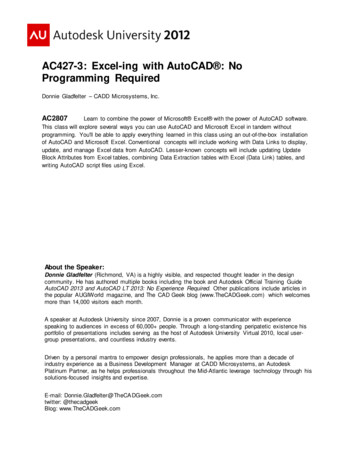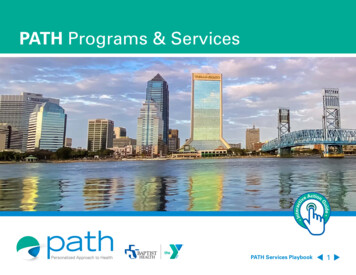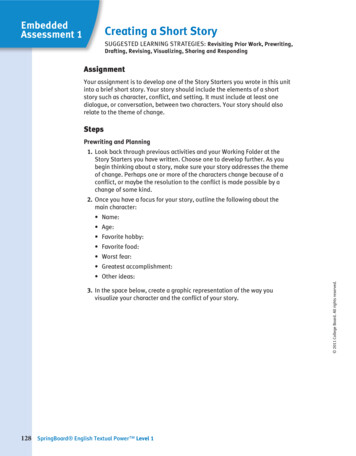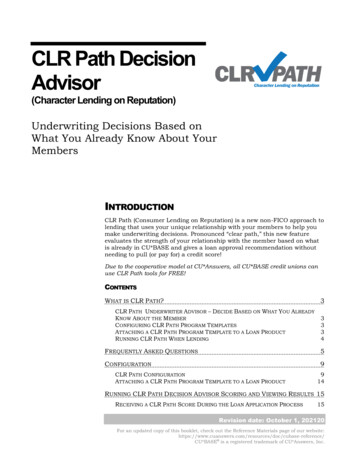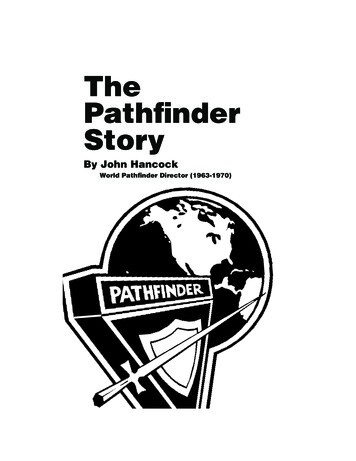
Transcription
ThePathfinderStoryBy John HancockWorld Pathfinder Director (1963-1970)
Copyright 1994 NAD PathÞnder MinistriesRevised June 2003, November 2003, February 2004Edited by Sheila DraperDesigned by Glen MilamAdditional copies of this book are available fromAdventSource5040 Prescott AvenueLincoln, NE 685061-800-328-0525www.adventsource.orgAll rights reserved. This book may not be used or reproduced withoutwritten permission from the copyright holder. Reprinting the contentas a whole for giveaway or resale is expressly prohibited.Printed in the United States of America2
ContentsDedicationAbout the AuthorStory of PathfinderingEarly BeginningsSummer CampPathfindersThe Pathfinder SongCamporeesWitness Through RosesTeen PathfindersPathfinder LeadershipHow Summer Camps BeganImportant Dates & Events569101416222628313134473
4
DedicationThis book is dedicated to all adults whochallenge young people to seek the highadventure in Christian service that PathÞnderMinistries can provide.Special thanks to John Hancock andthe pioneers of PathÞnder Ministries. ThesepeopleÑtrue PathÞndersÑshared their dynamismand their spiritual inßuence with young peoplein the Seventh-day Adventist Church and in thecommunity, and paved the way for the PathÞnderand Camp programs that we use today.Thanks also to the youth leaders who supportour young people when they respond to theMasterÕs call: ÒCome in the unity of the faith, andof the knowledge of the Son of God, unto a perfectman, unto the measure of the stature of the fullnessof ChristÓ Ephesians 4:13. These leaders helpPathÞnders discover their world and themselves,and they enthusiastically teach PathÞnders tobelieve that they can be the people God intendedthem to be.A special tribute to todayÕs PathÞnders whowant to be great in the Lord. If you believe inyourself and have the courage, determination, andcommitment to your Lord and Savior, and if youare willing to sacriÞce the little things in life to payfor the things that matter, you will reach your goals.Norm MiddagNorth American Division Pathfinder Director(1986-1996)5
About theAuthorJohn H. Hancock, a native Californian,graduated from PaciÞc Union College andentered the ministry in the NorthernCalifornia Conference in 1939. He and his wifeHelen worked in pastoral evangelism until 1946,when he was called to bethe youth director of theSoutheastern CaliforniaConference. That year, heorganized a conferencesponsored PathÞnderClub at Riverside. In1947, he joined otheryouth directors in thePaciÞc Union to developthe PathÞnder Cluborganization. He servedas youth director inboth the Lake UnionConference (1951-54)and the North PaciÞcUnion Conference (195463). In 1963, he wascalled to the GeneralConference YouthDepartment to serve asworld PathÞnder director, and then served as WorldYouth Director from 1970-80.6
Youth around the world remember him notonly for his stories and his inspiring Christ-centeredmessage of hope andcourage, but also as theÒman with the accordion.ÓHis custom-madeinstrument traveled withhim everywhere, because,as he said, Òit does notneed to be translated.ÓIn 1972, heorganized youth ministrytraining seminars atAndrews Universityand later in overseasdivisions. In 1992,ÒJohn HancockYouth CentersÓ wereestablished at La Sierraand Andrews Universities in his honor.John and Helen were married for over 52 yearsand had a daughter and two sons, and now havenine grandchildren. After HelenÕs sudden death in1990, he married Charlotte ÒLollieÓ Keller in 1991.She appears with him in the picture here. They bothattended many PathÞnder activities each year.John Hancock passed away February 22, 2001.7
Pathfinder PledgeBy the grace of God,I will be pure, kind and true.I will keep the PathÞnder Law.I will be a servant of Godand a friend to man.Pathfinder LawKeep the Morning Watch,Do my honest part,Care for my body,Keep a level eye,Be courteous and obedient,Walk softly in the sanctuary,Keep a song in my heart andGo on GodÕs errands.8
Story ofPathfinderinghe North American Division PathfinderDepartment presents Elder John Hancock,former World Pathfinder Director and one ofthe pioneers in the introduction and development ofthe Pathfinder Club, giving his first-hand record ofthe roots and history of Pathfindering. This will bethe most accurate historical account of this subjectthat has thus far been presented. (Editor's Note:The 2003 edition contains the on-going history ofthe Pathfinder organization as recorded by Arnoldand Dixie Plata)ÒHello!Ó to all you wonderful people whoare interested in becoming involved in the nicestwork ever given to manÑworking for boys andgirls of the Seventh-day Adventist Church throughPathÞndering.These youth are not only the churchÕs future,but a very important part of today. We are livingin the last days, just before Jesus returns, and assomeone has said, ÒTimeÕs most noble offspringis its last.Ó To work with these youth is a greatprivilege. It is important to know where we camefrom and where we are going. I wish I could tellthis story face-to-face, but this booklet will be away to contact thousands with an accurate accountof PathÞnder history.How did PathÞndering get started, and whoparticipated in its beginnings and development?Well, PathÞndering is not something whichsuddenly appeared as the brainchild of one person.Its roots go back to the beginning of this century,and many individuals making contributions toyouth ministry were involved. In this booklet, we9
will examine the historical developments whichled to the adoption of the PathÞnder Club programby the General Conference at their session in SanFrancisco. The PathÞnder world-wide programbecame ofÞcial in 1950.Early Beginningsrom 1879-1907, many local churches andschools experimented with junior youthsocieties. In response to this grass-roots interest inyouth ministry, the General ConferenceF10voted to establish a youth departmentin 1907 with Elder M. E. Kern as theÞrst secretary, or director, and MatildaErickson became the assistant secretary.During that year, church leadersinvolved in education and youthministry met at Mount Vernon, Ohio.They studied the program and namedthe new youth organization ÒSeventhday Adventist Missionary Volunteers.ÓMV Societies, as they were called forsenior youth were quite popular. At agathering in Colorado in 1909, thesesame leaders voted in a program for junior youth,ages 10-15, and JMV Societies were establishedin churches and schools. An aim "The AdventMessage to All the World in This Generation" anda motto ÒThe Love of Christ Constraineth UsÓ wereadopted. Each member also pledged that, ÒLovingthe Lord Jesus, I promise to take an active part inthe young peopleÕs MV Society, doing what I canto help others and to Þnish the work of the gospel inall the world.ÓElder Kern was also, from 1910-1914, presidentof the Foreign Mission Seminary (WashingtonMissionary CollegeÑColumbia Union College)and spent as much time in the Þeld as possibleand also did much writing. During the 1920'sElder Kern spent most of his time in other landsÑAustralia, South America, China and the Far East,India, Africa, EuropeÑas the young people's work
throughout the world developed. In1912 Meade MacGuire was made a Þeldsecretary of the MV Department to servein overseas assignments.By 1911, several boysÕ clubs, suchTakoma Indians and WoodlandClan, were started by Charles Boydin the state of Maryland and BoysPal in Lincoln, Nebraska formed byas theP. Robinson. In 1919, downNashville, Tennessee, Arthur W.Spalding organized the MissionMiltoninScouts for his own children and theirneighborhood friends.Spalding wasa very resourceful person and wrote apledge and a law, which later becamethe basis for the presentPathÞnderC. Lester Bond 1888 -Pledge and Law.In 1915 the Seventh-day Adventist Church heldja oint countrywide convention of thekand Missionary Volunteer wor ers in1971EducationalSaint Helena,California. That same year Ella Iden-Edwards wasadded as an assistant Þeld secretary in the MissionaryVolunteer Department. Most notable in her service8 Junior Manual.was preparation of the 191To foster the junior/youth program the GeneralConference called Harriet Maxson Holt to theMissionary Volunteer department in 1920.As thejunior/youth secretary, she promoted JMV Societiesin churches and schools and in 1922 introduced the"JuniorandProgressive Missionary Volunteer" FriendCompanion classes. Another class,Comrade was designed for older youthand youth leaders.had completed theWhen an indvidualComrade classthey could, with additional study anda normal course of 7 requirements,became MasterComrades.Also in 1922, Henry T. Elliott,from successful conduct of thek in the Lake Union, wasyouth worModel AirplaneHonor11
brought to join the General Conference MissionaryVolunteer staff. In 1924, the Junior Manualwas revised and brought up to date, includingthe Progressive Class plans, by Harriet Holt andArthur Spalding. During these years Harriet Holtand Arthur W. Spalding worked together to laythe groundwork for what would later become theworldwide PathÞnder program.In 1928, when Harriet's husband, ChesterHolt, was elected to be the PaciÞc Union YouthDirector, C. Lester Bond replaced her as AssociateMV Secretary in charge of Junior Youth Ministry.Elder Bond was a great leader. During his longterm of service (1928-1946) there was muchgrowth in the MV and JMV programs. Elder Bondintroduced Vocational Merits and asked ArthurW. Spalding to help develop requirements forthem. In 1928, 16 Vocational Merits were offeredand during that same time a group of dedicatedyouth workers toiled to present a handbook to aidboys and girls in their Christian growth. HarrietMaxson Holt and Julia Leland aided in preparationof the inspirational sections; Arthur W. Spaldingworked on 19 additional Vocational Merits andKathryn L. Jensen RN aided in the preparation ofthe First Aid and other health related requirements.A number of other youth workers helped and inMarch of 1929 the name Vocational Merits waschanged to Vocational Honors. When the JuniorMissionary Volunteer Handbook was published in1929 it included 35 Vocational Honors. It was notuntil the revision of this publication, in 1931, thatthere were drawings of these 35 Vocational Honortokens. Elder Bond did a lot of his work whiletraveling by ship to visit the world divisions. In1932 the Camp Leader's Handbook, which ElderBond helped to write was published. In 1933 hisÞrst devotional book, God's Challenge to Youthwas published by Southern Publishing Association.In 1934 his second devotional book, Adventurersin Christian Living was published by the Review12
and Herald Publishing Association. In 1938 theMaster Guide Manual and Ideals for Juniors ereublished and also Stamp Collecting hich herote in colaboration ith er in . hurber.ro 19 8 19lder ond ser ed as one o theAssociate ditors o the Youth's Instructor andas also on the book coittee o the e ieand Herald Publishing Association. In 1950 lderond's book or senior youth, The Quest of Youth,as ublished.In 1931, in order to de onstrate the JuniorWork, a s ecial in estiture o all class le els, asheld during eetings o the General Con erence.i ty three aster Co rade Pins ere a arded atthis ti e as ell as nu erous ins in the three otherclass le els.In 1930, Henry . lloitt as elected GeneralSecretary o the V De art ent and in 1933he beca e associate secretary o the GeneralCon erence Secretarial De art ent, a ositionhe held or 5 years. Al red W. Peterson Þlledhis lace, as General Con erence V GeneralSecretary, in 193 , a osition he held or t el eyears. A. W. Peterson ga e igorous leadershiin the youth ork. lder Peterson as called tobe young eo le's secretary o the AustralasianDi ision in 19 3.At this ti e, any youth leaders and educatorsbelie ed that the Scout rogra had so e excellentideas. ut they also elt that it ould be di Þcult orSe enth day Ad entist juniors to join the oy orGirl Scout organization because o Sabbath, dietaryand other di erences. So they used the Scoutrogra as a base and de elo ed clubs o theiro n.lder ldine W. Dunbar beca e an AssociateSecretary to the V de art ent in 19 3, ollo inghis ser ice as Young Peo le's issionary VolunteerSecretary or the PaciÞc Union. He beca e theGeneral issionary Volunteer Secretary in 19 .lder Dunbar as best kno n or his 39 yearspwwww M v RTF m 2 - 46 E BvfEfwmm f R v wEBfw pmpvfv wmffFf - Mmw wm wm pvTE wf M p mmffp mpf 2fpfM4 pf w vvvpw Ewp pfv4m mvp mmBfwf fv vBfffp mv pfwE EmM p m4 f wvp MfmM46Eww f13
of work with youth. He led out in organizing thePathÞnder Club and was instrumental in settingstandards for the youth organization's Master Guidelevel. Elder Dunbar devoted his life to helpingyouth learn of God's love and the plan of salvation.In 1946, Elder Laurence A. Skinner and ElderTheodore E. Lucas became Associate Secretariesof the General Conference Youth Department.Both men worked to enhance the PathÞnder aswell as Senior youth programs. Elder Skinner hadpreviously conducted Trailblazer Clubs (a programwritten by Henry T. Bergh) in the North PaciÞcUnion and well understood the need of dedicatedleaders to work with the youth of the church.Summer Campuring these formative years, summer camps inthe Adventist church were just beginning togrow. The very Þrst camp was held in Australiain 1925. In the North American Division theWisconsin Conference held a girls camp, followingCampmeeting, August 4-14. Followed by aboys camp in Michigan, at Townline Lake, withdirector Grover Fattic MV Secretary, in 1926. Thefollowing year both Michigan and Wisconsin heldyouth camps for boys and girls. An interesting sidelight to these camps is that to attend the junior musthave completed and been invested in the FriendClass. Illinois heldDthe PathfinderCounselors atdanrseentluary Volso next page)Junior Missionmp in 1933. (ACangniaiTrerIdyllwild Summ14
camp in 1928, and other conferences followedtheir example. Early youth leaders of these campsincluded Arthur W. Spalding, I. Smith, GroverFattic, Roy McKenzie, Wilbur Holbrook, Eldine W.Dunbar, F. G. Ashbaugh, and C. Lester Bond.The West held its Þrst summer camps in 1928.Julia Nelson directed a camp in Angeles NationalPark for the Southern California Conference.Central California Conference held its Þrst campat Wawona when Eder John F. Simon took boysand girls to camp in the woods of Yosemite.Mrs. Emma Simon, a schoolteacher and parent,was the cook at this Þrst adventure. At Julian,near San Diego, camp directors Guy Mann andLaurence Skinner held a camp for the SoutheasternCalifornia Conference. Arthur Spalding, a guestfrom the General Conference, told pioneer storiesat campÞre each night. One of these stories wasabout John Fremont, a PathÞnder. Explorer JohnFremontÕs name is very familiar in California and atthe capital, in Sacramento, you can Þnd a lot abouthim.The name ÒPathÞnderÓ caught the imaginationof the youth leaders in Southeastern California, andthe next year a second camp was held at Idyllwild,in the San Jacinto Mountains. In 1930 this15
campsite was purchased by the Conference, and apermanent summer camp facility was built on the151/2 acres and was christened the ÒJMV PathÞnderCampÓ. The Conference used the site for more thanthirty years before it was sold so a larger campcould be purchased. A new permanent camp wasdeveloped at Pine Springs Ranch, in 1961, on 480acres in the San Jacinto Mountains.PathfindersIKn the mid nineteen twenties, John Mc im, aScoutmaster decided that something should bedone for unior youth in the Anaheim, CaliforniaSeventh day Adventist Church where he was amember. e had a oy Scout Troop but li e otherAdventist youth leaders, he believed that the churchneeded its own club, patterened after the Scoutsbut with an added spiritual emphasis. nder thedirection of the Southeastern California Conferenceouth irector, uy Mann, John Mc im and hiswife ertha wor ed together to have a club forboys and girls. illa Steen and her husband r.Claude Steen, members of the ullerton Seventhday Adventist Church wor ed with the Mc im s.The boys and girls clubs met wee ly and were veryactive in community parades with a marching bandand doing community outreach as well as going oncampouts and day outings. Mrs. illa Steen startedup the range County Junior Choir, which sangin many churches in the area. They called the clubPathÞnders.At the Santa Ana Seventh day AdventistChurch, ester and one Martin felt the need tooffer a similar club e perience for the boys of hischurch. hen they loo ed for a place large enoughto hold these meetings they contracted r. TheronJohnston, an ophthalmologist and a member ofthe Santa Ana church. r. Johnston and his wifethel had moved into a large home in 1929 andthey graciously agreed to allow their home to bea meeting place. ncidently that home was still-jHBkUYBDGkWKkK 'kWOLIW-xkDEI16DFD-
standing in 2003. The boys met downstairs, in thebasement workshop area, with Mr. Martin as theirdirector and Dr. Johnston as the assistant director.Dr. & Mrs. Johnston had two daughters. Theireldest daughter, Maurine helped her father set upfor the club meetings, but when the boys appeared,she had to vanish, and complained strongly that itwasn't fair. So it wasn't long before her mother, Mrs.Ethel Johnston, and Ione Martin became the girl'sdirectors.Now the question arose, ÒWhat will we call thisclub?Ó As the name ÒPathÞnderÓ was now part ofSoutheastern Conference junior youth vocabulary,these church members decided to call themPathÞnder clubs. Things went well for a while, butthen some of the older Santa Ana Church membersbegan thinking that the club activities were bringingthe world into the church, and they were stronglyopposed to that idea. The club activities were similarto what PathÞnders do todayÑcrafts, games, naturestudies, cycling, Þeld trips, and so on. The churchboard voted to request that Martin and Johnstondisband their club. The board sent them threateningletters stating that if the clubs were not disbandedimmediately, church discipline would be applied.Needless to say, this ended this club in SoutheasternConference, at least until after World War II, whenthe GIs came home and were ready for action.In the Õ30s and Õ40s, one man who kept theclub idea alive was Laurence A. Skinner. Afterworking as Junior Youth Leader for SoutheasternCalifornia, he was called to serve as Youth DirectorÞrst in Hawaii and later in the Southern CaliforniaConference. While there, he organized church clubsfor juniors, but he was counseled by the GeneralConference to keep the name JMV rather than goingto another name like PathÞnders. In the early 1940s,Elder Skinner became the Youth Director for theNorth PaciÞc Union. One of his Þrst undertakingswas to promote the Trailblazer Club, which wasorganized very similarly to what would later become17
the basic outline for PathÞnder Clubs.Although the Santa Ana church hadrejected the PathÞnder idea and McKimof the Anaheim-Fullerton Church haddisbanded his club because of ill healthit would not be long until the PathÞnderclub idea would become a permanentpart of the Southeastern CaliforniaConference and in all the PaciÞc Union.In the mid-1940s, regionalconferences were organized and WalterKisack, director of the Lake RegionConference Youth Department, startedthe Þrst camping program for AfricanAmericans. In 1955 Leon Davis, who- 2002ce Skinner 1905Laurenfollowed Kisack, transferred to NewYork and developed such outstandingcamp programs at Victory Lake Camp in HydePark, New York, that more campers attended hiscamps than any other camp in North America.In 1946, Elder John Hancock was called fromhis pastorate in the Santa Ana church to becomeYouth Director for Southeastern CaliforniaConference. This happened right in the middle ofthe camping season at Idyllwild, and my ConferencePresident, Elder H. H. Hicks, called me on thephone and said, ÒJohn, we want you to comeimmediately and be director of our Idyllwild JMVCamp and also Youth Director for the Conference.ÓWell, this was quite an initiation for me! But havingserved at camp as a counselor in previous years, andwith the support of friends there at camp, I knewthey could get through the summer. God blessed,and we had a very Þne camping season. After theseason was over, my wife Helen and our three smallchildren moved from Santa Ana to Riverside. TheConference bought a new parsonage on GardenaDrive by the Santa Fe railroad tracks. We usedto say that the railroad ran through the middle ofthe house. I set up my ofÞce in the Conferenceheadquarters, which was located in Arlington.18
At the end of the summer and after we weresettled, a mother came into my ofÞce and said,ÒElder Hancock, I wish that summer camp couldlast all year long!Ó Well, I was a bit surprised atthis comment, and remarked that I was sure thecounselors were glad the camp didnÕt last a wholeyear. In those days, our staff was comprised almostentirely of Conference workers and pastors andteachers, and the Conference Committee assignedthem to work at these 10-day camps. But when Isaw the earnest expression on this motherÕs face, Iinquired, ÒWhy do you wish this to happen?Ó I willnever forget her reply. She said, ÒBecause my soncomes home from camp with the light of heaven inhis eyes.Ó Well, this motherÕs response made mewonder, ÒWhy canÕt summer campÑthe activitiesand the fellowshipÑlast all year?ÓI was acquainted with the Trailblazer program,that Henry T. Bergh had written, as Elder Skinnerhad given me a copy. In fact, I had all theorganizational plans in my ofÞce. I got these out,looked at them, and decided to call Stan Jefferson,the pastor of the Riverside Church where my wifeand I were members. He was a good friend, so Iasked, ÒStan, would you be interested in joiningme and getting a club going for the boys and girls10-15 years old in your church?Ó StanÕs responsewas an enthusiastic "Yes!" You see, his daughterwas in that age bracket. I consulted with severalMaster Comrades and other workers who hadhelped at Idyllwild. They offered good counseland encouraged me to go ahead. So we did. Butwhat would we call such a club? Why, whatelse in Southeastern California Conference but aPathÞnder Club? In my ignorance as a new youthdirector, I didnÕt know that the General ConferenceYouth Department did not want the name of JMVto be changed. I guessed that if Henry Bergh andLaurence Skinner had Trailblazers in the NorthPaciÞc Union, we certainly could have PathÞndersin our conference, especially since that name wasso prominent in youth ministry history.19
Because I had majored in art in high schooland at Chico State College, I decided to design asleeve emblem for the new club uniform. I didnÕtwant PathÞnders to be another Boy Scout Troop,although the Scouts had been very kind to work withC. Lester Bond and others, letting them use muchof the material in the Scout Handbook. I wantedPathÞnders to be Christ-centered, so I thought abouthow this emblem should look. It would be in theshape of a triangle, with the three sides representingthe spiritual, physical, and social aspects ofchild development. I put a shield in the center tosymbolize faith in Jesus and a sword on top of theshield to represent the Word of God. These emblemswere made up in a local embroidery shop.While the emblems were being made, we hadto decide on a uniform. We were able to get suntanuniforms for men and boys at Army Surplus storesright after the war, but for the girls, it was indeeda different story. My wife Helen and some of themothers whose children would be members of theclub went to work to make girlsÕ uniforms. Helensearched the pattern companies for the right pattern.The Conference then bought bolts of green cloth,wholesale, which we stocked in our ofÞce. Werecruited a college ministerial student, Francis Hunt,to be the club director.In the fall of 1946, the PathÞnder Club madeits debut in the Riverside church. There were about15 boys and girls in that club. Their parents werevery supportive. We didnÕt have a clubhouse, so weused the school ground of the Clafßin MemorialRiverside School. GIs who had returned and werenow students at La Sierra College led the drills andmarching. Vocational Honor classes were held inparentsÕ homes.One of the most popular classes was BAKING,taught by Helen in our little home on Gardena Drive.The class was popular because at the end of eachclass, the boys could eat all the goodies they made.After all, someone has said a boy is an appetite20
with skin stretched around it! Well, we took thosePathÞnders on outings to county recreational parksand on Þeld trips.We also decided to teach Master Comradeclasses for the counselors. LawrencePaulson, a lay-worker who had started aclub in Glendale in 1947, often came overand helped us with these classes, whichwere held in a classroom at La SierraCollege.Lawrence and I worked closelytogether during those days. He named hisclub PathÞnders and used the emblemwhich I had designed. I visited hisPathÞnders Club Birthday Party aftertheir Þrst year, and he had 150 clubmembers at that time. Incidently, I Lawrence W. Paulson 1901 - 1998consider Lawrence Paulson to be oneof the greatest all-time PathÞnder club directorsin our denomination. From 1947 onward, he wasresponsible for organizing and directing twelvedifferent church PathÞnder clubs in Southernand Southeastern California Conferences. Healso helped in PathÞnder Leadership Institutesnationwide. Even in his retirement years, hecontinued to be active in PathÞnders.After the Riverside and Glendale clubs beganto prosper, other clubs sprang up here and there.In Central California Conference Henry T. Berghencouraged a Mrs. Lorna Esry, a member of theSunnyvale Seventh-day Adventist Church to starta PathÞnder club. By the spring of 1949 ElderBergh had organized 23 PathÞnder Clubs in hisConference.Elder Bergh was also the Þrst Youth Directorto use PathÞnder Area Coordinators throughouthis conference, in 1949, to better serve all the clubleaders.In 1949 the momentum was so strong thatElder E. W. Dunbar, Youth Director for theGeneral Conference and Elder L. A. Skinner, who21
was now Associate Youth Director for the GeneralConference, believed it was time to move forwardwith the whole idea. Elder Skinner contacted J. R.Nelson, PaciÞc Union Youth Director, and said,ÒJoe, can you bring your local conference youthdirectors in the PaciÞc Union together and askthem to develop the PathÞnder club idea?Ó ElderNelson said, ÒWeÕll do it,Ó as he was really in favorof PathÞndering. So, from 1949-1950, this wasdone with great success and dispatch. The PaciÞcUnion Conference Youth Directors, at that time,which were involved in working with the newprogram were: John H. Hancock and Lee Carterfrom Southeastern California Conference, MillerBrockett from Southern California Conference,Henry T. Bergh from Central California Conferenceand Clark Smith from the Nevada/Utah Conference.The Pathfinder Songn the spring of 1949, the PaciÞc Union youthleaders met for the MV DirectorÕs Council.IAmong other items that were worked on, JohnHancock suggested to Henry Bergh that he writea PathÞnder song. Henry replied, ÒIÕm no songwriter. IÕve never written a song and I am nota musician.Ó In a letter written to the WorldPathÞnder Director, Michael Stevenson in 1984,Elder Bergh wrote, ÒI dispatched that idea veryquickly. But along in May 1949, I was driving to aSabbath appointment at Monterey Peninsula fromSan Jose (70-80 miles). I was riding along thinkingabout PathÞnders and about our need for the songand started thinking about a tune. What would bea good tune for a PathÞnder song? Then I thought,well, I could write the words. So I tried to composea poem.É I started thinking of what things wouldI want to put in the poem for a PathÞnder song. Ithought about the JMV pledgeÑpure and kind andtrue, with a message to go to the world, and thingsstarted to fall into place. I pulled over to the side ofthe road, took a piece of paper out of my Bible, and22
began to write:Oh, we are the Pathfinders strong,The servants of God are weFaithful as we march alongIn kindness, truth, and purity.A message to tell to the world,A truth that will set us freeKing Jesus the Savior's coming backFor you and me.W ll, I h u h , h Õs d.É I k fff my S h pp m d dh d ys d s d hum u . Th Is dsh ds h h u . I h v s dp dly h G d v m h u c us I mmus c d I h v vs f s c . Th L d jusv m . I pull d ff h s d f hd, u d h sh f p p v , dpu d Þv l s f s ff. I ku h u mus cld, s I s d humm h u h sh u h my m d d pu d s hs ff.É Th vh I h m , I sk d myf M m pl y h s h f m f m h d sh p . W c c d h I h d m spl c dh d s d h u jus s s d y. I s lls Õ c Þd hs d u hfP hÞ d S , s I sWy H p ,h s p s l f d f u s d h muc s ld c f h d p m V c f P ph cy. Isk d W y d d h m z . H sck d s d, ÔI Õs d s Ñ h d dpu l sh !Õ S m m ph d f us mu P hÞ d clu s ( h C l C l fC f c ). I h k h h Þ s m s llyduc d c f c - d sc l s hP hÞ d OfÞc Õs C vAsc l m ,M y, CA, J u y f 1950.Ó A s dh s s y s h f m Eld B h. "Iet o g t t at not batoo oagain orabbat a oint ent an got ownt e roa a wa an tarte toa t neentarte inging t e wor wit t at t nea e aire eatet at o ga e e t e t ne be a e anot ai ian ana e ne er writtena ong be ore or in ee ortga e it to ee o t e i eo t eroa t rne t e eet o a er o er ant own e ine or a taneweno g abo ti to be ab e to reait o tarteing t e t ne t at wagoing t ro gin antting ot on t etaat e ening w en got o e a ewi e iria to a t i t ing or e ro t e oton t e age e orre te w ere ai a et e ot an got t e t ne t a it i to atiwa n t on ent t at it wa goo eno g or aat n er ong o ent it to a ne oo erw o i a er ona rien o o r an t eiaire tor or t e ra io rograoi e o ro ea ea ne to e it it an to ar oni e it e entit ba an ait a goo ong go a ea anb i it o we i eogra e it or e a ongo r at n er b in t e entra a i orniaon eren e t in t at t e r t ti e it wa reaintro e on a on eren e wi e a e wa at t eat n ereron ention ini i
3 Contents Dedication 5 About the Author 6 Story of Pathfi ndering 9 Early Beginnings 10 Summer Camp 14 Pathfi nders 16 The Pathfi nder Song 22 Camporees 26 Witness Through Roses 28 Teen Pathfi nders 31 Pathfi nder Leadership 31 How Summer Camps Began 34 Important Dates & Events 47



